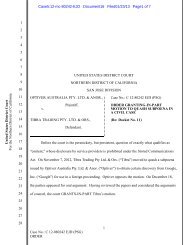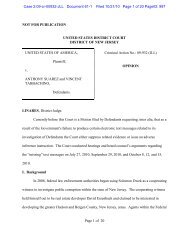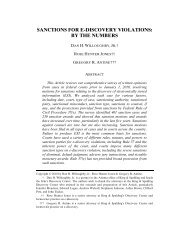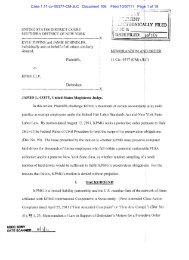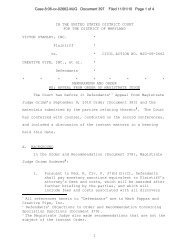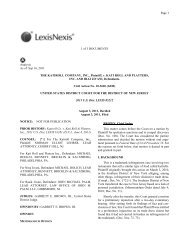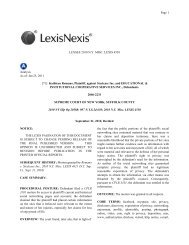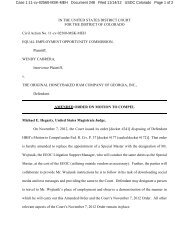Rimkus Consulting Group Inc. v. Cammarata - Ballard Spahr LLP
Rimkus Consulting Group Inc. v. Cammarata - Ballard Spahr LLP
Rimkus Consulting Group Inc. v. Cammarata - Ballard Spahr LLP
You also want an ePaper? Increase the reach of your titles
YUMPU automatically turns print PDFs into web optimized ePapers that Google loves.
Case 4:07-cv-00405 Document 450 Filed in TXSD on 02/19/10 Page 116 of 139<br />
determine whether a customer list is a trade secret: “(1) what steps, if any, an employer has<br />
taken to maintain the confidentiality of a customer list; (2) whether a departing employee<br />
acknowledges that the customer list is confidential; and (3) whether the content of the list is<br />
readily ascertainable.” Guy Carpenter & Co. v. Provenzale, 334 F.3d 459, 467 (5th Cir.<br />
2003). In considering whether information was readily ascertainable, courts have considered<br />
the expense of compiling it. See Zoecon Indus. v. Am. Stockman Tag Co., 713 F.2d 1174,<br />
1179 (5th Cir. 1983) (“Even if the names and addresses were readily ascertainable through<br />
trade journals as the defendants allege, the other information could be compiled only at<br />
considerable expense.”). 44<br />
Other Texas courts focus on the method used to acquire the<br />
customer information. Even if the information is readily available in the industry, it will be<br />
protected if the competitor obtained it working for the former employer. See Brummerhop,<br />
840 S.W.2d at 633; Am. Precision Vibrator Co. v. Nat’l Air Vibrator Co., 764 S.W.2d 274,<br />
277 (Tex. App.—Houston [1st Dist.] 1988, no writ) (“In Texas, courts condemn the<br />
Magazines In-Flight, LLC, 990 F. Supp. 119, 129–30 (E.D.N.Y. 1997) (holding that the plaintiff’s customer<br />
lists were not trade secrets because the customer identity could be easily found through publicly available<br />
means, such as the internet, trade shows, trade directories, and telephone books, or were imbedded in the<br />
defendant’s memory); Millet v. Loyd Crump, 96-CA-639, pp. 5–6 (La. App. 5 Cir. 12/30/96); 687 So. 2d 132,<br />
136 (holding that the trial court erred in concluding that customer lists were trade secrets under the Uniform<br />
Unfair Trade Secrets Act because the defendant had monthly access to the files to complete an ongoing audit,<br />
the defendant could obtain client information when clients contacted her directly, and insurance companies<br />
and policy holders also had the information alleged to be confidential).<br />
44 See also Crouch v. Swing Machinery Co., 468 S.W.2d 604, 607 (Tex. Civ. App.—San Antonio 1971, no<br />
writ) (“[T]here is evidence to the effect that the important information relates not to the identity of particular<br />
businesses which might purchase plaintiff’s products, but the identity of officers or other employees of such<br />
concerns who make the decisions concerning the purchase of such equipment. There is also evidence which<br />
at least tends to show that ascertaining the identity of such key personnel requires the expenditure of<br />
considerable time and money.”). Courts have also considered the difficulty of compiling the customer list to<br />
determine whether it is confidential. See M.N. Dannenbaum, <strong>Inc</strong>. v. Brummerhop, 840 S.W.2d 624, 632 (Tex.<br />
App.—Houston [14th Dist.] 1992, writ denied).<br />
116



